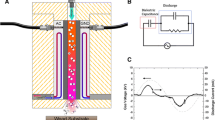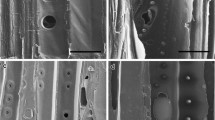Abstract
This work reports the functionalization of sugar maple (Acer saccharum) wood surfaces following their exposure to the jet of an atmospheric-pressure dielectric barrier discharge operated in either Ar or N2 with C3F8 (octafluoropropane) as the growth precursor for plasma-enhanced chemical vapour deposition. Analysis of the current–voltage characteristics (I–V) revealed a filamentary behaviour in all conditions. While more intense current peaks were observed after addition of C3F8 in Ar, a decrease in the discharge current was seen in N2/C3F8 plasmas. Optical emission spectroscopy showed the apparition of a CF2 + continuum and CF2 rovibrational bands between 225 and 350 nm with increasing applied voltage and precursor concentration in the Ar plasmas; a feature ascribed to the presence of plasma-generated C3F8 fragments. In such conditions, water contact angle (WCA) measurements indicated that freshly sanded wood samples became highly hydrophobic, with WCAs in the 140° range and excellent dimensional stability for a period of up to 125 days. X-ray photoelectron spectroscopy revealed that such behaviours result from the deposition of highly hydrophobic CF x groups on the surface. On the other hand, no increase in surface hydrophobicity was observed following exposure to the jet of N2/C3F8 plasmas, probably due to their much lower precursor fragmentation levels.









Similar content being viewed by others
References
Abbasipour M, Salem MK, Sari AH, Abbasipour M (2012) Wood surface functionalization by means of low-pressure air plasma. Radiat Eff Defects Solids 167(11):814–825
Avramidis G, Hauswald E, Lyapin A, Militz H, Viöl W, Wolkenhauer A (2009) Plasma treatment of wood and wood-based materials to generate hydrophilic or hydrophobic surface characteristics. Wood Mat Sci Eng 4(1–2):52–60
Bente M, Avramidis G, Förster S, Rohwer EG, Viöl W (2004) Wood surface modification in dielectric barrier discharges at atmospheric pressure for creating water repellent characteristics. Holz Roh Werkst 62(3):157–163
Borcia G, Chiper A, Rusu I (2006) Using a He + N2 dielectric barrier discharge for the modification of polymer surface properties. Plasma Sources Sci Technol 15(4):849–857
Busnel F, Blanchard V, Pregent J, Stafford L, Riedl B, Blanchet P, Sarkissian A (2010) Modification of sugar maple (Acer saccharum) and black spruce (Picea mariana) wood surfaces in a dielectric barrier discharge (DBD) at atmospheric pressure. J Adhes Sci Technol 24(8–10):1401–1413
Cheng C, Liye Z, Zhan R-J (2006) Surface modification of polymer fibre by the new atmospheric pressure cold plasma jet. Surf Coat Technol 200(24):6659–6665
Chirokov A, Gutsol A, Fridman A (2005) Atmospheric pressure plasma of dielectric barrier discharges. Pure Appl Chem 77(2):487–495
Donath S, Militz H, Mai C (2006) Creating water-repellent effects on wood by treatment with silanes. Holzforschung 60(1):40–46
Fanelli F, d’Agostino R, Fracassi F (2007) Atmospheric pressure PE-CVD of fluorocarbon thin films by means of glow dielectric barrier discharges. Plasma Processes Polym 4:797–805
Fanelli F, Fracassi F, d’Agostino R (2008) Fluorination of polymers by means of He/CF4-fed atmospheric pressure glow dielectric barrier discharges. Plasma Processes Polym 5(5):424–432
Fanelli F, Lovascio S, Arefi-Khonsari d’Agostino R, Fracassi F (2010) Ar/HMDSO/O2 fed atmospheric pressure DBDs: thin film deposition and GC–MS investigation of by-products. Plasma Processes Polym 7(7):535–543
Gherardi N, Gouda G, Gat E, Ricard A, Massines F (2000) Transition from glow silent discharge to micro-discharges in nitrogen gas. Plasma Sources Sci Technol 9:340–346
Hardy J-M, Levasseur O, Vlad M, Stafford L, Riedl B (2015) Surface free radicals detection using molecular scavenging method on black spruce wood treated with cold, atmospheric-pressure plasmas. Appl Surf Sci 359:137–142
Hsieh C-T, Chang B-S, Lin J-Y (2011) Improvement of water and oil repellency on wood substrates by using fluorinated silica nanocoating. Appl Surf Sci 257(18):7997–8002
Levasseur O, Stafford L, Gherardi N, Naude N, Blanchard V, Blanchet P, Riedl B, Sarkissian A (2012) Deposition of hydrophobic functional groups on wood surfaces using atmospheric-pressure dielectric barrier discharge in helium–hexamethyldisiloxane gas mixtures. Plasma Processes Polym 9(11–12):1168–1175
Levasseur O, Stafford L, Gherardi N, Naude N, Beche E, Esvan J, Blanchet P, Riedl B, Sarkissian A (2013) Role of substrate outgassing on the formation dynamics of either hydrophilic or hydrophobic wood surfaces in atmospheric-pressure, organosilicon plasmas. Surf Coat Technol 234:42–47
Levasseur O, Profili J, Gangwar RK, Naude N, Clergereaux R, Gherardi N, Stafford L (2014) Experimental and modelling study of organization phenomena in dielectric barrier discharges with structurally inhomogeneous wood substrates. Plasma Sources Sci Technol 23(5):054006
Liu C, Cui N, Brown NMD, Meenan BJ (2004) Effects of DBD plasma operating parameters on the polymer surface modification. Surf Coat Technol 185(2–3):311–320
Mai C, Militz H (2004) Modification of wood with silicon compounds. Treatment systems based on organic silicon compounds—a review. Wood Sci Technol 37(6):453–461
Massines F, Gherardi N, Naude N, Segur P (2005) Glow and Townsend dielectric barrier discharge in various atmosphere. Plasma Phys Controlled Fusion 47(12B):B577–B588
Massines F, Gherardi N, Naude N, Segur P (2009) Recent advances in the understanding of homogeneous dielectric barrier discharges. Eur Phys J Appl Phys 47(2):22805
Massines F, Sarra-Bournet C, Fanelli F, Naude N, Hjerardi N (2012) Atmospheric pressure low temperature direct plasma technology: status and challenges for thin film deposition. Plasma Processes Polym 9(11–12):1041–1073
Noeske M, Degenhardt J, Strudthoff S, Lommatzsch U (2004) Plasma jet treatment of five polymers at atmospheric pressure: surface modifications and the relevance for adhesion. Int J Adhes Adhes 24(2):171–177
Odraskova M et al (2007) Diffuse coplanar surface barrier discharge assisted deposition of water repellent films from N2/HMDSO mixtures on wood surface. In: 28th ICPIG, July 15–20, 2007, Prague, Czech Republic
Odrášková M, Rahel J, Zahoranová A, Tiňo R, Černák M (2008) Plasma activation of wood surface by diffuse coplanar surface barrier discharge. Plasma Chem Plasma Process 28(2):203–211
Poaty B, Riedl B, Blanchet P, Blanchard V, Stafford L (2013) Improved water repellency of black spruce wood surfaces after treatment in carbon tetrafluoride plasmas. Wood Sci Technol 47(2):411–422
Podgorski L, Chevet B, Onic L, Merlin A (2000) Modification of wood wettability by plasma and corona treatments. Int J Adhes Adhes 20:103–111
Podgorski L, Bousta C, Schambourg F, Maguin J, Chevet B (2002) Surface modification of wood by plasma polymerisation. Pigm Resin Technol 31(1):33–40
Potočňáková L, Hnilica J, Kudrle V (2013) Increase of wettability of soft- and hardwoods using microwave plasma. Int J Adhes Adhes 45:125–131
Prégent J, Vandsburger L, Blanchard V, Blanchet P, Riedl B, Sarkissian A, Stafford L (2015a) Determination of active species in the modification of hardwood samples in the flowing afterglow of N2 dielectric barrier discharges open to ambient air. Cellulose 22(1):811–827
Prégent J, Vandsburger L, Blanchard V, Blanchet P, Riedl B, Sarkissian A, Stafford L (2015b) Modification of hardwood samples in the flowing afterglow of N2–O2 dielectric barrier discharges open to ambient air. Cellulose 22(5):3397–3408
Riedl B, Angel C, Pregent J, Blanchet P, Stafford L (2014) Effect of wood surface modification by atmospheric pressure plasma on waterborne coating adhesion. BioResources 9(3):4908–4923
Sèbe G, Brook MA (2001) Hydrophobization of wood surfaces: covalent grafting of silicone polymers. Wood Sci Technol 35:269–282
Setoyama K (1996) Surface modification of wood by plasma treatment and plasma polymerization. J Photopolym Sci Technol 9(2):243–250
Trunec D, Navratil Z, Stahel P, Zajickova L, Bursikova V, Cech J (2004) Deposition of thin organosilicon polymer films in atmospheric pressure glow discharge. J Phys D Appl Phys 37(15):2112–2120
Wascher R, Schulze N, Avramidis G, Militz H, Viöl W (2014) Increasing the water uptake of wood veneers through plasma treatment at atmospheric pressure. Eur J Wood Prod 72(5):685–687
Xie L, Tang Z, Jiang L, Breedveld V, Hess DW (2015) Creation of superhydrophobic wood surfaces by plasma etching and thin-film deposition. Surf Coat Technol 281:125–132
Zanini S, Riccardi C, Orlandi M, Fornara V, Perla Colombini M, Donato DI, Legnaioli S, Palleschi V (2008) Wood coated with plasma-polymer for water repellence. Wood Sci Technol 42(2):149–160
Acknowledgments
This work was supported by the National Science and Engineering Research Council (NSERC), the Fonds de Recherche du Québec—Nature et Technologies (FRQNT) and the Association Nationale de la Recherche (ANR). O. Levasseur acknowledges NSERC, the Fonds de Recherche du Québec Nature et Technologies (FRQNT), and FPInnovations for the Industrial Innovation Scholarship.
Author information
Authors and Affiliations
Corresponding author
Rights and permissions
About this article
Cite this article
Levasseur, O., Vlad, M., Profili, J. et al. Deposition of fluorocarbon groups on wood surfaces using the jet of an atmospheric-pressure dielectric barrier discharge. Wood Sci Technol 51, 1339–1352 (2017). https://doi.org/10.1007/s00226-017-0958-x
Received:
Published:
Issue Date:
DOI: https://doi.org/10.1007/s00226-017-0958-x




